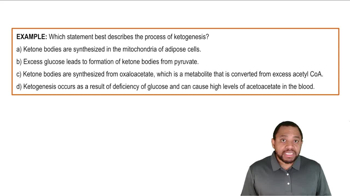Which of the following classifications apply to the formation of 3-hydroxybutyrate from acetoacetate?
a. Condensation
b. Hydrolysis
c. Oxidation
d. Reduction
 Verified step by step guidance
Verified step by step guidance Verified video answer for a similar problem:
Verified video answer for a similar problem:



 1:29m
1:29mMaster Ketone Bodies Concept 1 with a bite sized video explanation from Jules
Start learning